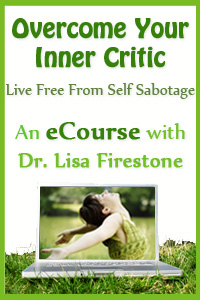Identify Your Critical Inner Voice
 The critical inner voice is an internal dialogue, a harsh and judgmental way of talking to ourselves. It is evident in those little everyday thoughts that flit through our consciousness: “You idiot, why did you say that? Now everyone will think you are stupid.” “You moron, you never should have taken this route in rush hour.”
The critical inner voice is an internal dialogue, a harsh and judgmental way of talking to ourselves. It is evident in those little everyday thoughts that flit through our consciousness: “You idiot, why did you say that? Now everyone will think you are stupid.” “You moron, you never should have taken this route in rush hour.”
The critical inner voice often takes the form of an on-going commentary in our mind that interprets events and interactions in ways that cause us pain and distress. In essence, it operates as a filter through which we negatively interpret our lives.
As we go through each day, we experience many events and are involved in numerous social interactions in personal relationships and at work. Our reactions to these are influenced to a large degree by our inner voice, so they are different depending on the strength of our voice attacks. If we are viewing life through the negative filter of the critical inner voice, life may look bleak and gloomy. If, on the other hand, our view of life is unfiltered and clear, free of the voice’s interference, the same situation or event may look bright and optimistic to us.
For this reason, events that happen to us are often not the primary cause of our distress. Trouble usually arises from the incidents being interpreted through the critical inner voice. For example, when we are viewing ourselves from this unfriendly perspective, we feel self-critical or demoralized if we make a mistake, no matter how small or unimportant. At these times, we exaggerate the consequences of our mistakes and tell ourselves that we will continue to fail. We may even tell ourselves that we will never succeed at anything we try and that we should give up altogether.
As you become more aware of this enemy within, you can come to understand what is operating when you become self-critical and interpret events in a negative way. This understanding is the first step toward change. Once you recognize the destructive influence of the critical inner voice, you can choose to ignore its dictates and live life from a more realistic point of view, free from imagined constraints and limitations.
Watch a Whiteboard Video on The Critical Inner Voice
Recognize what triggers your critical inner voice
One of the most effective strategies for combating the inner voice is becoming aware of situations and experiences that typically trigger its attacks on you. When you find yourself slipping into a bad mood or becoming upset, think about what happened to change your mental state. The fact that went from feeling optimistic or relaxed to feeling down or irritable may be a sign that your voice has been activated.
For example, if, during the past week, you observed that your mood switched from feeling relatively happy and content to feeling down, try to recall the event or interaction that occurred immediately prior to the shift in your feelings. After thinking about the details of the event or conversation, try to remember what you were telling yourself at the time. Although many situations and encounters can be distressing or anxiety producing, it is the way that we interpret these events or situations that is at the crux of the problem. What we tell ourselves about the event, about ourselves, and about the other person, or people involved, has a much more significant effect on our feelings and our state of mind than the event itself.
When criticism triggers your critical inner voice
Your critical inner voice is often triggered by criticism or feedback even when it is constructive information offered by friends, family members, co-workers, or employers. It appears that all of us are much more sensitive to feedback when it fits in with specific negative attitudes we already have toward ourselves. No matter that the criticism is coming from caring people with our best interests at heart, we often react negatively because we imagine that it is coming from someone as hostile toward us as we are toward ourselves. At these times, our over reactions are out of proportion to the content or severity of the negative feedback we have received.
Identifying your critical inner voice
Simply recognizing that you are involved in a process of self-attack is valuable in challenging the voice. However, you can to one step further and identify the contents of your self-attacking process.
Most people experience the attacks of their critical inner voice in the first person as “I” statements. It is helpful to put these self-attacks into the second person, “you,” as though someone else were saying them to you. Because your critical inner voice represents an alien point of view, it is more accurately depicted in the second person. In this format, the snide and sarcastic tone of the critical inner voice becomes apparent and the hostile nature of this internal enemy is exposed. Expressing the critical inner voice in the second person (1) helps make a distinction between the negative point of view of yourself and a more realistic view; (2) makes you aware of other negative thoughts that you may not have been conscious of before; and (3) accesses the feelings that are often associated with these thoughts.
Keeping a Journal
Keeping a journal can be an effective tool for helping you identify and challenge your critical inner voice. Divide a page in half by drawing a line down the middle of the page from top to bottom. On the left side of the page, record negative thoughts toward yourself that you experience during the day. Be sure to write these thoughts as your critical inner voices in the second person, “you,” that is, as though someone were talking to you.
It is helpful to devote 10 to 15 minutes at the end of your day to recalling the negative thoughts you experienced that day. Just let these thoughts flow. Don’t censor yourself. Give full expression to your negative thoughts. Don’t be afraid of them. You don’t have to believe them or act on them. Getting them out in the open, writing them down, will actually give you more control over them. Get to know all the aspects of your negative thinking. Also don’t worry if the thoughts are not logical. Remember that the voice is irrational and the thoughts often contradict each other. After you have finished writing your critical thoughts on the left-hand side of the page, take some time to go back over them. Check to make sure you have written them all in the second person.
Next, on the right-hand side of the page, in relation to each attack, try to express a more friendly, compassionate and realistic view of yourself, your qualities, and your reactions. What would a close friend or an objective observer say or see about you and about the situation? Write this more accurate view of yourself on the right-hand side of the page. Make sure to write it in the first person, as “I” statements. This is not meant to be an exercise where you buoy yourself up with self-affirmative statements, but rather where you look at yourself from an objective but compassionate point of view. How do you see yourself?
If you do this exercise on your computer, follow the first step and write down your critical inner voices (in the second person). When you are done, go back into your document and, after each attack, write your objective view of yourself (in the first person).
Throughout the week, continue to keep a record of the negative thoughts you experience each day, always in the second person, followed by a more compassionate view of yourself written in the first person. At the end of the week, review your journal. Look for any areas in which attacks recur. In the future, you can be aware that these areas are vulnerable to attack by your critical inner voice. Were any of your attacks triggered by specific events? Now when these events occur, you can be on the look out for self-attacks.
Tags: critical inner voice, defenses, negative thoughts, self-critical thoughts, self-esteem, self-limiting behaviors









GREAT ARTICLE…I think the things that trigger it for me are:
1) bad foods
2) not going on walks, and
3) not socializing…
I also think there
s certain inherent human needs that we all have, and distressing emotions come up when we don’t get those needs met…like
>> the need to connect with others,
>> the need for renewal and relaxation,
>> certain nutritional needs,
Etc, etc. The journaling is great too because it allows you to question and interrogate your own self-doubt.
Tight material. I’m about to read your post on addictions now.
Peace,
+B
i’ve learned how to just turn off the critical inner voice.
Your blog post really hit on every important aspect of being healthy and happy, it really comes down to exactly this. I’ll be following your future blog posts, they are really well written and informative. Keep up the great work and happy blogging 🙂
Thank YOU for helping me my situation in a different perspective
Hey , I’m a bit confused about folding the paper and what goes into the 2nd half of the page and what also is supposed to be written underneath the stuff I have written on first half.
Can you help pls